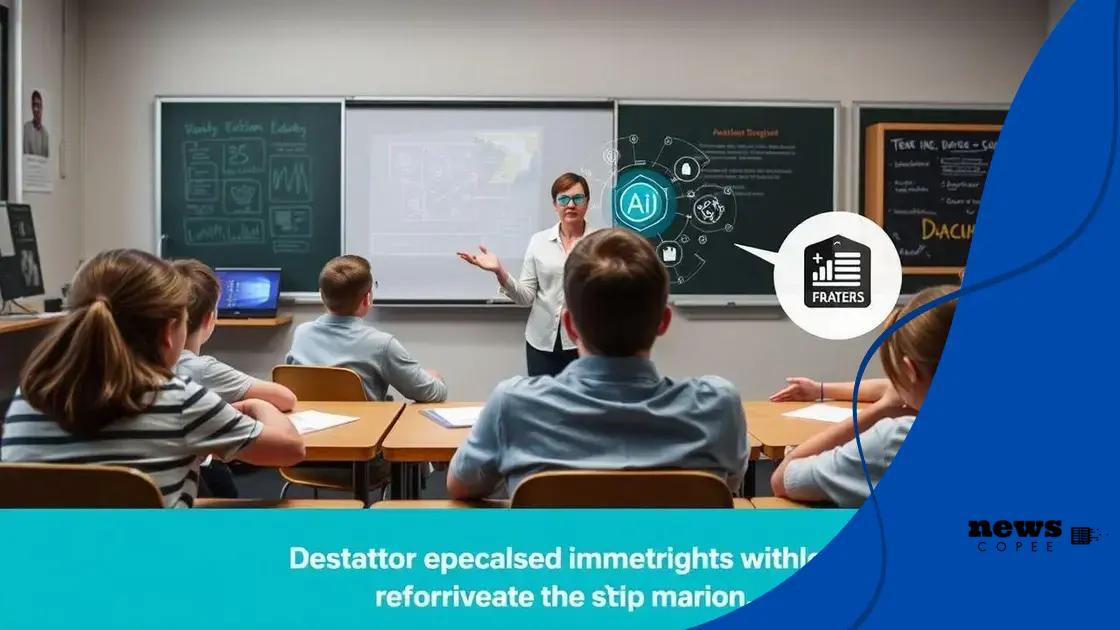AI now used more in classrooms: a shift in education

AI now used more in classrooms enhances personalized learning, improves engagement through interactive tools, and helps teachers with data-driven insights, transforming traditional education methods significantly.
AI now used more in classrooms is changing the educational landscape. Have you ever wondered how technology shapes learning experiences? In this article, we’ll uncover how AI enhances education.
Understanding the role of AI in education
The role of AI in education is becoming increasingly important. Schools are looking for ways to improve learning and engage students. With the advent of technology, we have a unique opportunity to enhance the educational experience.
What is AI in education?
AI refers to the use of software that can mimic human intelligence. It helps in personalizing education by analyzing student data. This leads to tailored learning experiences that fit individual needs.
Benefits of AI in the classroom
Using AI in the classroom can create several benefits:
- Enhanced student engagement through interactive learning.
- Real-time feedback for both teachers and students.
- Personalized learning plans for each student.
- Automation of administrative tasks, allowing teachers to focus on teaching.
With these advancements, teachers can spend more time helping students and less time on paperwork. As a result, the classroom becomes a more dynamic and immersive environment.
Not only does AI support students, but it also aids teachers. For example, AI-driven analytics can help identify student strengths and areas needing improvement. This ensures that educators can provide the support their students need to succeed.
Moreover, AI technology can provide additional resources that motivate students. By offering diverse learning tools, students can choose the formats that work best for them. This flexibility caters to different learning styles, promoting a more inclusive environment.
Challenges with AI implementation
Despite the benefits, there are challenges to consider when integrating AI in education:
- Cost of implementing AI tools.
- Need for teacher training to utilize AI effectively.
- Data privacy concerns regarding student information.
- Ensuring equitable access to technology for all students.
As we move forward, it’s essential to address these issues to harness the full potential of AI in education. By working collaboratively, educators, policymakers, and tech developers can create a framework that supports students and teachers alike.
Benefits of AI in the classroom
One of the biggest benefits of AI in the classroom is its ability to help students learn at their own pace. By analyzing learning patterns and performance, AI can customize educational experiences. This means that each student can receive lessons tailored to their individual strengths and weaknesses.
Enhanced engagement
AI tools make learning more interactive and exciting. For instance, using AI-based applications can gamify lessons, turning education into a fun experience. This encourages students to participate actively.
Improved feedback
Another advantage is the real-time feedback AI provides. Students no longer have to wait days to learn how they performed on tests. Fast feedback helps students understand their mistakes and make necessary adjustments quickly. This leads to a deeper understanding of the material.
AI also assists teachers by automating routine tasks. With the help of AI, teachers can now spend more time focusing on teaching rather than grading papers or managing schedules. This shift allows for a more personal approach to teaching, where educators can better connect with students.
The versatile nature of AI in education makes it a powerful ally for teachers. It can identify which concepts each student struggles with, enabling educators to provide targeted interventions. By focusing on specific areas, students receive the support they need to succeed.
Access to resources
AI can also open doors to new resources. With tools like virtual tutors and AI-driven study aids, students have access to a wealth of knowledge beyond the traditional classroom. This enhances their research skills and encourages independence.
Furthermore, AI can facilitate collaboration among students. For instance, AI platforms can connect students with similar interests, creating opportunities to work together on projects. This not only builds teamwork skills but also fosters a sense of community in learning.
Challenges teachers face with AI implementation

While the integration of AI in education offers many advantages, it also presents several challenges that teachers must navigate. Understanding these challenges is crucial for successful implementation.
Cost of AI tools
One significant hurdle is the cost associated with acquiring AI technologies. Many schools may find it difficult to budget for the necessary software and hardware. This can lead to disparities between schools with different funding levels, affecting student access to quality education.
Training and support
Additionally, teachers need proper training to effectively use AI tools. Many educators may feel overwhelmed or unprepared to incorporate these technologies into their teaching. Providing ongoing support through professional development is essential, but not always available.
- Workshops to enhance skills in using AI tools.
- Access to resources and guides for educators.
- Peer support networks for sharing experiences and tips.
Another challenge is the issue of data privacy. With the use of AI, students’ data is often collected and analyzed. Schools must ensure that they are protecting this sensitive information and complying with regulations, which can be complex and time-consuming.
Moreover, the reliability of AI systems is a concern. If the algorithms are not accurate, they may give misleading information or feedback, which can impact students’ learning experiences negatively. Therefore, teachers must critically assess the tools they use.
Equity in access
Finally, ensuring equitable access to AI resources among all students can be difficult. Not every student has access to the latest devices or high-speed internet, posing a barrier to effective learning. Schools need to find ways to bridge this gap to ensure all students can benefit.
In summary, while AI has the potential to transform education, recognizing and addressing these challenges is vital for teachers. By doing so, educators can maximize the benefits of AI in the classroom and enhance their students’ learning experiences.
How students are adapting to AI tools
As AI tools become more common in education, students are learning to adapt to these technologies. With this shift, they are experiencing new ways of learning and interacting with information.
Embracing new technology
Many students find that using AI-driven platforms in their studies makes learning more engaging. For example, interactive apps allow them to practice math problems or explore science concepts at their own pace. This personalized experience can increase their confidence and motivation.
Collaborative learning
Students are also adapting by using AI tools to collaborate with their peers. With platforms that enable group projects, they can work together, sharing ideas and resources. This enhances their ability to communicate and solve problems collectively.
- Improved teamwork skills.
- Access to diverse perspectives and solutions.
- Enhanced creativity through brainstorming with others.
As they become familiar with these technologies, students often develop digital literacy skills that will benefit them throughout their lives. Learning to navigate AI tools effectively prepares them for future careers that will likely rely on technology.
Additionally, students are learning to critically assess the information provided by AI systems. With the vast amounts of data available, they are encouraged to think critically about the sources and accuracy. This analytical mindset is essential in today’s information age.
Balancing screen time
However, adapting to AI tools also requires students to find a healthy balance with screen time. They are learning the importance of taking breaks and not relying solely on technology for their education. This awareness helps them maintain their well-being and focus on various activities beyond the screen.
In essence, students are navigating a new educational landscape with AI. They are learning to embrace technology while developing essential skills and ensuring a balanced approach to their learning experiences.
Future trends of AI in education
The future of AI in education is promising and full of potential innovations. As technology continues to evolve, schools and educators are exploring new ways to leverage AI tools to enhance learning experiences.
Personalized learning experiences
One major trend is the shift towards even more personalized learning. AI systems will use data to create customized lesson plans tailored to each student’s pace and style. This flexibility allows teachers to focus on individual needs better, ensuring that every student can succeed.
Integration of virtual reality
Another exciting development is the integration of virtual reality (VR) with AI. When combined, these technologies can create immersive learning environments. For instance, students could explore historical events or dive into the ocean to learn about marine life in a more engaging way.
- Experiential learning opportunities.
- Increased student engagement.
- Enhanced understanding through visualization.
This blend of AI and VR not only makes education more engaging but also helps students retain information longer by providing hands-on, interactive experiences.
Enhanced formative assessments
AI will also improve assessment methods in the classroom. Teachers will use AI-driven tools to analyze student performance more effectively. These tools can provide insights into areas where students might be struggling, allowing for timely interventions.
Additionally, assessments will evolve from traditional tests to more dynamic evaluations that consider a student’s progress over time. This approach promotes a growth mindset and encourages continuous learning.
Collaboration with AI assistants
In the classroom, we expect to see increased collaboration between students and AI assistants. These AI tools can help answer questions, provide feedback, and assist in research, allowing teachers to focus on facilitating discussions and deeper learning.
As students become more comfortable using these AI tools, their ability to conduct independent research and solve problems will grow significantly, preparing them for future challenges.
Overall, the future trends of AI in education show great promise in transforming traditional classrooms into dynamic learning hubs. With advancements in technology, students will have unprecedented opportunities to learn, collaborate, and succeed.
AI in education is reshaping the way students learn and teachers teach. The future looks bright with promising trends like personalized learning and virtual reality experiences, which make education more engaging. Students are becoming adept at using AI tools, which helps them develop critical skills needed for their academic and future careers. Despite challenges, such as cost and training, the benefits of AI far outweigh the hurdles. Overall, AI’s role in classrooms will continue to evolve, leading to richer learning experiences for all students.
FAQ – Frequently Asked Questions about AI in Education
What are the main benefits of using AI in the classroom?
AI enhances personalized learning, provides real-time feedback, and helps automate administrative tasks, allowing teachers to focus more on student engagement.
How can AI tools assist students in their learning?
AI tools can adapt to individual learning styles, helping students grasp concepts at their own pace and making learning more engaging.
What challenges do teachers face when implementing AI?
Teachers may encounter issues like the cost of AI technologies, the need for training, data privacy concerns, and ensuring all students have equitable access.
What future trends can we expect with AI in education?
Future trends include more personalized learning experiences, integration of virtual reality, improved assessments, and enhanced collaboration between students and AI assistants.
